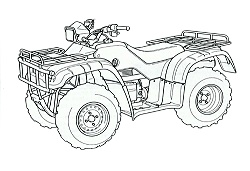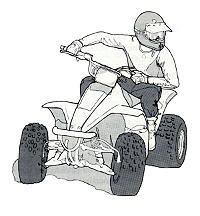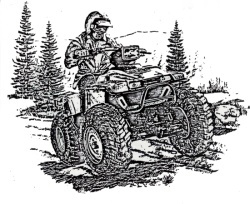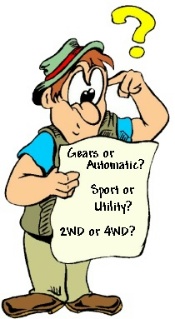Buying your first ATV
| Buying Your First ATV Which Type is Right For You? |
 |
What’s a Utility Quad?
 Utility quads are exactly what the name implies. They are work- rather than leisure-oriented, the type of quad used for chores around the farm, trailer towing or carrying your camping gear for an overnight excursion. Utility quads typically have a stiffer suspension, full skid plates, large racks, tow hitch and four-stroke engines. Because utility quads have large tires, the body plastic is larger and offers better mud protection than either sport or sport-utility machines. Utility quads have the heavier and more durable driveshaft rather than the chain and sprocket system used on sport quads. Utility quads with gears have a super-low first gear and offer excellent torque. Most utility quads also offer a low-range subtransmission for heavy-duty slugging, and don’t have manual clutches. They also have large racks with which you can load up a good deal of weight. Depending on model, anywhere from 150-pounds to 250+ pounds. If you will be towing a lot of equipment or will be using the quad for agricultural purposes, strongly consider a liquid-cooled engine. Despite being designed for work purposes, utility quads are still great for recreational trail riding. They are generally easier to learn how to ride than sport machines. They are the largest and heaviest type of quad. First-time riders will feel much more at home with this class of quad. Utility machines comprise roughly 80% of the ATV market. Examples of utility quads are the Honda Rubicon and Kawasaki Prairie.
Utility quads are exactly what the name implies. They are work- rather than leisure-oriented, the type of quad used for chores around the farm, trailer towing or carrying your camping gear for an overnight excursion. Utility quads typically have a stiffer suspension, full skid plates, large racks, tow hitch and four-stroke engines. Because utility quads have large tires, the body plastic is larger and offers better mud protection than either sport or sport-utility machines. Utility quads have the heavier and more durable driveshaft rather than the chain and sprocket system used on sport quads. Utility quads with gears have a super-low first gear and offer excellent torque. Most utility quads also offer a low-range subtransmission for heavy-duty slugging, and don’t have manual clutches. They also have large racks with which you can load up a good deal of weight. Depending on model, anywhere from 150-pounds to 250+ pounds. If you will be towing a lot of equipment or will be using the quad for agricultural purposes, strongly consider a liquid-cooled engine. Despite being designed for work purposes, utility quads are still great for recreational trail riding. They are generally easier to learn how to ride than sport machines. They are the largest and heaviest type of quad. First-time riders will feel much more at home with this class of quad. Utility machines comprise roughly 80% of the ATV market. Examples of utility quads are the Honda Rubicon and Kawasaki Prairie.
What’s a Sport Quad?
 Sport quads are the fastest and lightest machines. They have two- or four- stroke engines that are highly tuned for maximum performance. They have either five or six gears with a manual clutch and most come equipped with reverse. The gear ratios tend to be higher, meaning that the middle to upper part of the powerband is where all the power is. The long-travel suspension systems are dialed in to handle hard landings from jumps. Steering is quick and responsive. Cornering can be accomplished through a throttle and clutching technique or the use of body english and sliding the small-diameter tires through the sharpest bends. Body plastic is small and getting muddy is a way of life for the sport quad rider. Racks are non-existent and viewed as excess weight for jumping purposes. Weight is an important factor. Sport quads are smaller than utility machines and take a little longer to learn how to ride. All sport quads are chain-driven and two-wheel drive. Examples of sport quads are Yamaha’s Banshee and Honda’s 400EX. If you like fast trail riding and getting big air, this is the quad category for you. Bottom Line: Sport quads offer riding fun in varying degrees. The more money and riding experience you have, the bigger machine you should get.
Sport quads are the fastest and lightest machines. They have two- or four- stroke engines that are highly tuned for maximum performance. They have either five or six gears with a manual clutch and most come equipped with reverse. The gear ratios tend to be higher, meaning that the middle to upper part of the powerband is where all the power is. The long-travel suspension systems are dialed in to handle hard landings from jumps. Steering is quick and responsive. Cornering can be accomplished through a throttle and clutching technique or the use of body english and sliding the small-diameter tires through the sharpest bends. Body plastic is small and getting muddy is a way of life for the sport quad rider. Racks are non-existent and viewed as excess weight for jumping purposes. Weight is an important factor. Sport quads are smaller than utility machines and take a little longer to learn how to ride. All sport quads are chain-driven and two-wheel drive. Examples of sport quads are Yamaha’s Banshee and Honda’s 400EX. If you like fast trail riding and getting big air, this is the quad category for you. Bottom Line: Sport quads offer riding fun in varying degrees. The more money and riding experience you have, the bigger machine you should get.
All of the manufacturers offer at least one quad with an automatic transmission. All of the
 automatic ATVs on the market (except Honda’s Rubicon) are belt-driven. Automatic transmissions are nice to trail ride with and have been greatly improved over the last two years, but they don’t offer engine compression braking to the degree that geared machines do. This is important when descending steep hills, as the engine compression is also holding you back rather than the brakes alone. If it’s a downhill with small round boulders, brakes tend to lock up the tires easier than compression braking, which may cause a downhill slide–not a good situation. On the other hand, automatics are great for going up hills. There’s no delay in downshifting like on geared machines and the transmission stays in the meat of the powerband. Unless you want to be replacing belts, get a geared machine if you’ll be frequently towing. Bottom Line: Get the gears if you plan on a lot of utility-type work with the quad or routinely ride steep terrain. Get the automatic if you’re not comfortable with all the shifting.
automatic ATVs on the market (except Honda’s Rubicon) are belt-driven. Automatic transmissions are nice to trail ride with and have been greatly improved over the last two years, but they don’t offer engine compression braking to the degree that geared machines do. This is important when descending steep hills, as the engine compression is also holding you back rather than the brakes alone. If it’s a downhill with small round boulders, brakes tend to lock up the tires easier than compression braking, which may cause a downhill slide–not a good situation. On the other hand, automatics are great for going up hills. There’s no delay in downshifting like on geared machines and the transmission stays in the meat of the powerband. Unless you want to be replacing belts, get a geared machine if you’ll be frequently towing. Bottom Line: Get the gears if you plan on a lot of utility-type work with the quad or routinely ride steep terrain. Get the automatic if you’re not comfortable with all the shifting.
Do I really need four-wheel-drive?
Unless you like sport quads, if you live in the northern climates where you experience long snowy winters, getting a four-wheel drive quad is recommended. Four-wheel-drive quads offer you year-round use of the machine. Four-wheel-drive quads can travel in as much as 12″ of snow while the two-wheel-drives can’t move at all in that kind of depth. If you live in a snow-free environment, four-wheel-drive isn’t absolutely necessary unless you frequent deep mudholes and swamps. Personally, I’ll take four-wheel-drive all the time. It adds an element of security when mudding through the backwoods far from home and makes for more controlled hillclimbing and hill descending. There are people out there who will swear up and down that their two-wheel-drive can go wherever the four-wheel-drives can, but these people are seriously mistaken. They can argue with me, but they can’t argue with physics. Bottom line: If you can swing the extra money, go for the four-wheel-drive. If you ride moderate terrain and a limited amount of riding time, two-wheel drives are fine.
four-wheel drive quad is recommended. Four-wheel-drive quads offer you year-round use of the machine. Four-wheel-drive quads can travel in as much as 12″ of snow while the two-wheel-drives can’t move at all in that kind of depth. If you live in a snow-free environment, four-wheel-drive isn’t absolutely necessary unless you frequent deep mudholes and swamps. Personally, I’ll take four-wheel-drive all the time. It adds an element of security when mudding through the backwoods far from home and makes for more controlled hillclimbing and hill descending. There are people out there who will swear up and down that their two-wheel-drive can go wherever the four-wheel-drives can, but these people are seriously mistaken. They can argue with me, but they can’t argue with physics. Bottom line: If you can swing the extra money, go for the four-wheel-drive. If you ride moderate terrain and a limited amount of riding time, two-wheel drives are fine.

While the engine size on a utility quad is not a major factor, it plays a pivotal role with sport quads. If sport ATVs are yourstyle of riding gig and this is your first time buying an ATV, we strongly suggest that you start out with a smaller sized sport quad. It’s not absolutely necessary to get the biggest, baddest utility quad. It’s a rare circumstance indeed when a 500cc 4×4 goes somewhere a 300cc 4×4 can’t. If you do a lot of hillshooting in your local riding area you may want to go for the bigger engine, but if you’re not too concerned with flying up dirt banks or dunes, the 300cc quad will take you wherever the 500cc will, no problem. There are two advantages the larger big-bore quads offer. The frame is larger, so if you’re a tall person, you will feel more comfortable for all-day riding. The other advantage is that most of the larger-engine quads have liquid-cooling for all-day working in the fields. Bottom Line: Big engines are cool, but not absolutely necessary with a utility quad.

Utility quad size factor: Your height and weight aren’t as big a factor as they are with sport quads. Unless you’re a very largeperson (over 300 pounds), any utility machine should be able to haul you and your equipment around with relative ease. If you’re over 300 pounds, get one of the larger-sized engines. Your height plays a factor in that the larger-engined quads also have a larger frame. If you’re over 6’2″ you may get cramped during an all-day ride on a mid-size quad. Our suggestion is to sit on the quad that interests you in an upright position with your feet on the footpegs or floorboards. Take notice of the angle of your knee joint–a 90-degree angle is ideal. Bottom line: Mid-size quads will haul anyone around in relative comfort, except for the very large. The larger-engined utility quads will haul anybody around.
Sport Quad size factor: Small sport quads can be a little cramped for the taller person. However, if you have an aggressive riding style, your height may not be a factor. More often than not, you’ll be off the seat and in a standing or semi-crouched attack position anyway. Overall weight of the rider is only a factor in that the heavier you are, the shorter and lower your jumps will be. When cornering, your weight plays a major role when using body english. Of course, the heavier you are, the more steering response you’ll feel when swinging your weight to the inside corners. Bottom line: For maximum enjoyment, large people should get large sport quads. If you’re large and want to buy a small-sized sport quad, expect sore knees at the end of the day.
Summary
 Although we strive to make our ATV reviews as accurate and thorough as possible, we’d only be kidding ourselves if we thought our opinions were the final answer. Our suggestion is to read our reviews and check other available resources.
Although we strive to make our ATV reviews as accurate and thorough as possible, we’d only be kidding ourselves if we thought our opinions were the final answer. Our suggestion is to read our reviews and check other available resources.One final thought: Although most first-time riders feel anxiety about riding in challenging terrain, it’s important to remember that, statistically, ATV riding is more than three times as safe as snake handling.
